1. Overview
Chiang Mai is a mountainous province in the north of Thailand, home to verdant forests, large waterfalls, winding rivers, picturesque landscapes, etc. This is said to be the perfect place for outdoor enthusiasts looking for the most exciting trekking trails.
If you are traveling to Chiang Mai and are physically fit, you should join a trekking trip with interesting roads. The time for you to trek these roads is about a few hours, 1-2 days, sometimes up to a week, and you will be extremely satisfied with the things you obtain after the trip. The extremely beautiful natural scenes appear in front of your eyes—the villages and the simple life with the colors of Thai culture, etc. Discover the natural beauty of the most prominent trails on the Chiang Mai trekking tour in Northern Thailand.

2. Best Time to Chiang Mai Trekking
You can go trekking in Chiang Mai all year. Before planning your trip, consider the areas you will be visiting and then record the time to visit them. But the best time for trekking in Chiang Mai is from November to February. This period is perfect for you to trek through the forest with a cool wind and a less humid environment.
However, there are a few trips that are available throughout the year. You need to especially avoid the period of heavy rain that falls between July and September. Because the road up the hill when it rains will be extremely wet and you will not be comfortable.
3. Top 8 most prominent roads in Chiang Mai trekking tour
3.1. Trekking Doi Inthanon
Doi Inthanon is located about 100 kilometers southwest of Chiang Mai’s Old City in the Doi Inthanon National Park, the country’s tallest mountain boasting lush forests, ancient temples, and beautiful mountains nature trail with breathtaking panoramic views of the surrounding valley below.
The entrance to Doi Inthanon National Park is located at kilometer 8 of Provincial Road 1009. When you come here, you need to buy an entrance ticket for 8.55 USD.
Open: 5:00 a.m – 18:30 p.m
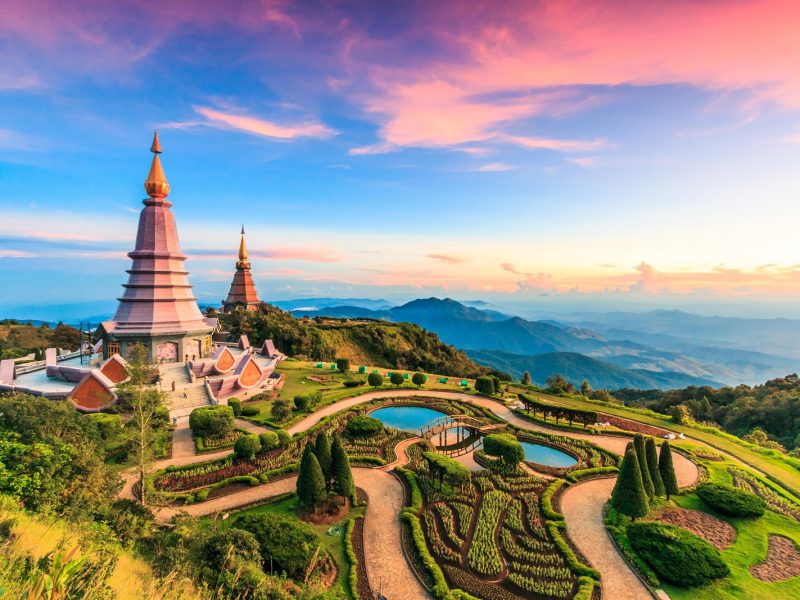
The trekking trail starts from road 1009 and has a length of 4.5 km, taking about 3-5 hours to reach the top of Doi Inthanon. You should ask a guide at the foot of the walking trail who can share knowledge about the area. The guides are usually from local villages and charge around 5.70 USD for the trip.
With this trekking route, you can explore the picturesque scenery of the area along with the rich flora and fauna of the forest in this national park. Around 300 species of birds fly to the summit throughout the year, and this national park is the most popular destination for birdwatching in the nation.
On this route, you will visit a village of the Karen or Hmong people, just one of many indigenous hill tribes living in Northern Thailand. Witness their unique customs and costumes firsthand, and even watch them create beautiful works of art, which can be purchased directly from them to help support their community.
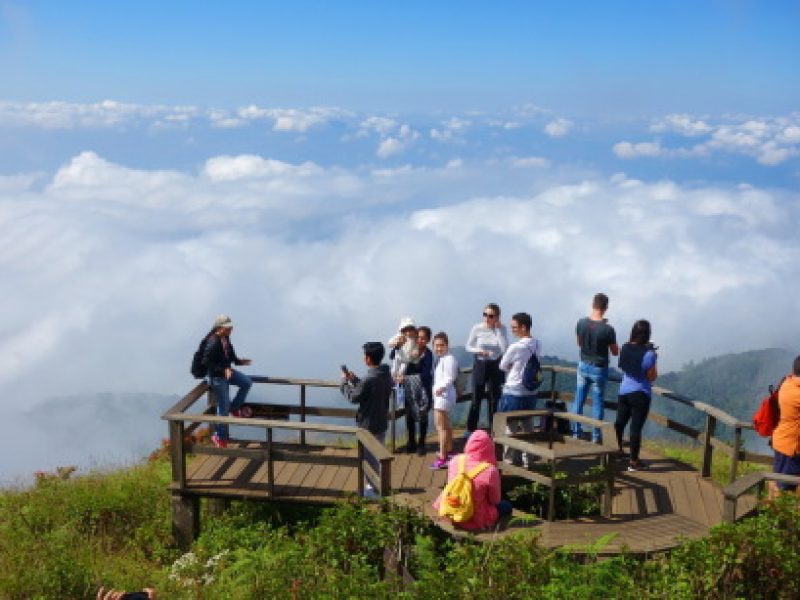
3.2. Trekking Ang Ka Nature Trail
Trekking along the Ang Ka Nature Trail is a must for nature lovers, and at a distance of just under 3km, it is one of the most accessible hikes for those who can moderate their force.
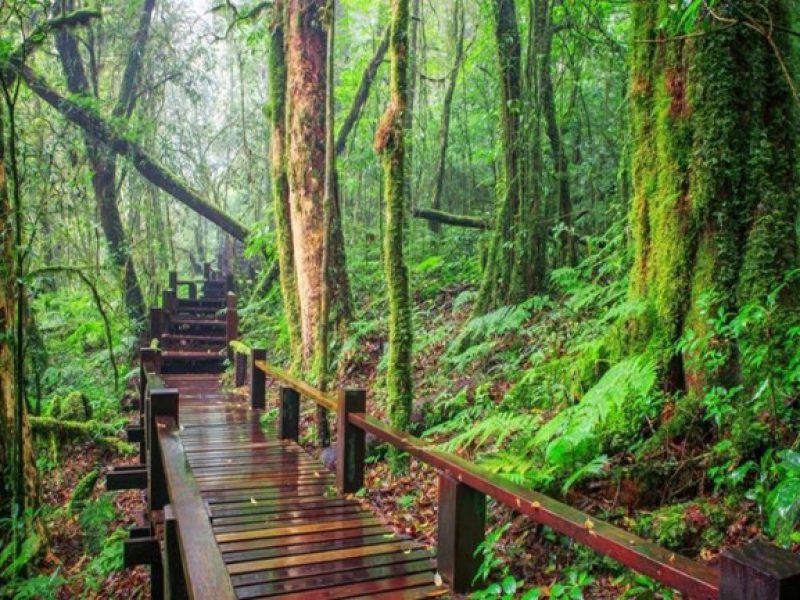
Opposite the Doi Inthanon hike is a wooded nature trail, the Ang Ka Nature Trail, that also leads to the summit of Doi Inthanon. This is a spacious trekking trail less than 1km long located at an altitude of 2,500m that takes you through dense forest on the highest mountain in Thailand. The road is built with pieces of wood put together when built close to the ground or high above.
Relax a bit and enjoy a delicious locally prepared Thai lunch before continuing on to the hilltop Hmong market. Here, you will be able to support local farmers by purchasing their grown fruits, vegetables, and teas.
In addition, You’ll experience two of the national park’s most impressive waterfalls: Sirithan Falls and Wachirathan Falls. As the tallest waterfall in the park, Wachirathan Falls is popular with visitors for the rainbow visible in the mist of the 80-meter waterfall.
See more:

3.3. Muang Kurt to Huay Kukap
Among the available trekking routes, one of Chiang Mai’s most prominent is the trekking route from Muang Kurt to Huay Kukap, giving you outstanding glimpses of hill tribe culture and alluring beauty. Also here, you can witness the outstanding scenery combined with enchanting mountains, lush greenery, and cascading waterslides.
Starting in Muang Kurt town, it’s a 600-meter hike up the mountain via a trail that includes a natural waterslide to Huay Kukap. At this place, you can discover the quiet and pleasant lifestyle of the inhabitants, and taking a dip in the cool waters of the creek can be a pleasant experience while traversing the rich rainforest areas to reach the farmland of Lahu.
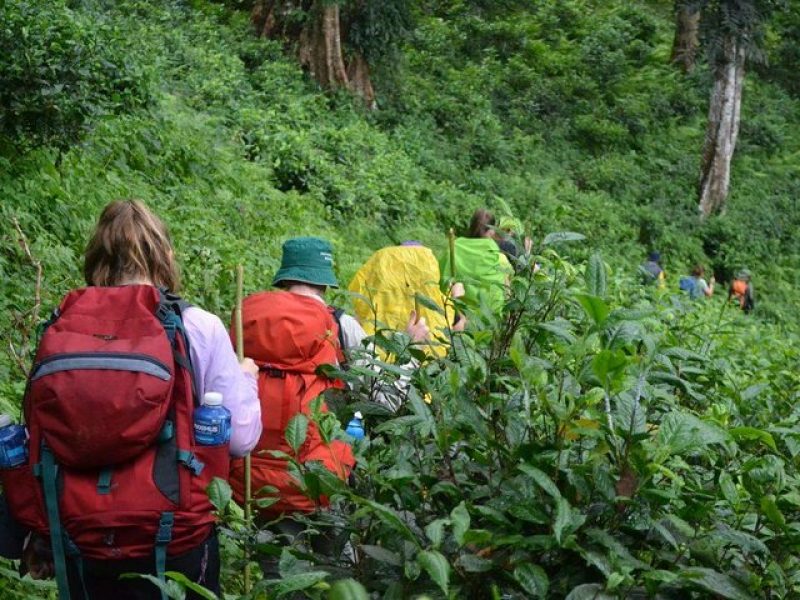
3.4. Trekking from Huay Kukap to Huaysatan Waterfall & Ta mok Mae Taeng River
Trekking through the forest from Huay Kukap to Huaysatan Waterfall and Ta Mok Mae Taeng River is quite popular. You’ll start trekking from Huay Kukap, and the hiking trail winds through dense forests. After walking for about 2 km, you will reach remote villages where you can learn about the traditional way of life of the villagers. Located 1 km from this location is the Huaysatan waterfall, which is considered the most beautiful waterfall in this region.
A further 1 km, guests can enjoy views of Ta Mok Waterfall, an idyllic place for swimming. Going 1.6 km down the stream bed is the Mae Taeng River, which is perfect for water fun such as swimming, bamboo rafting, whitewater rafting, etc.

3.5. Trekking Samoeng
Samoeng is beautifully located about 45 km southwest of Chiang Mai. Samoeng trekking starts from Samoeng area and ends at Mae Wang area. You can experience immense natural wonders, dense vegetation, and diverse flora and fauna while crossing the trails.
The Samoeng area is usually not very crowded because of the complicated trails, but the Mae Wang area is still packed with tourists. The Karen and Hmong tribes are the main inhabitants of this area, and visitors can enjoy the rural life to learn more about them.
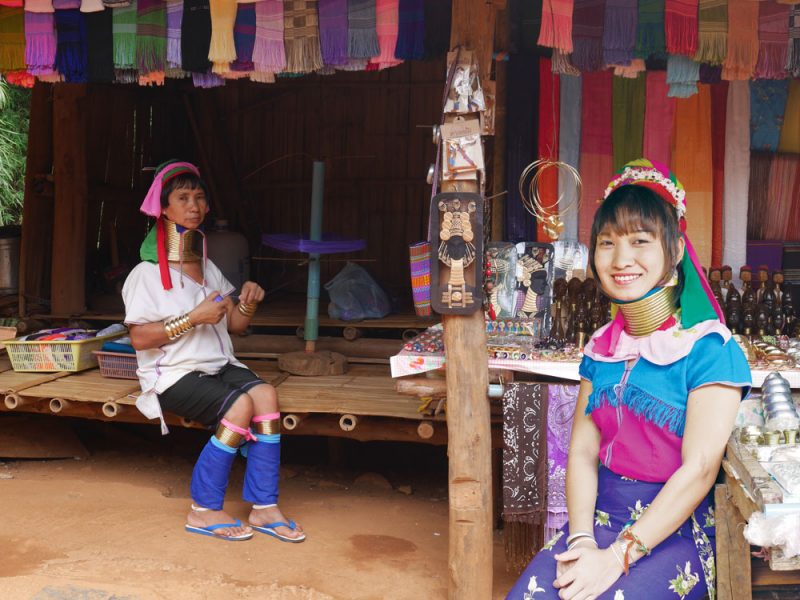
3.6. Trekking Doi Suthep
Doi Suthep is the most sacred and famous temple in the ancient city of Chiang Mai, Thailand. With a walking path from the bottom of the hill up to the temple on the top of the hill, the height of the hill is nearly 1700m. Because of this, this has become the most famous trekking place in Chiang Mai.
When participating in the Doi Suthep trekking tour, you will have special experiences during the hill-climbing journey. This hill is relatively easy to climb and is perfectly suitable for visitors who are just trying to trek for the first time. The destination of the trekking trip is the sacred temple of Doi Suthep on the top of the hill.
Trekking to Doi Suthep is also considered a great pilgrimage for tourists. In addition, the road during the trip is also extremely cool, with surrounding trees creating a very beautiful landscape in the eyes of visitors.
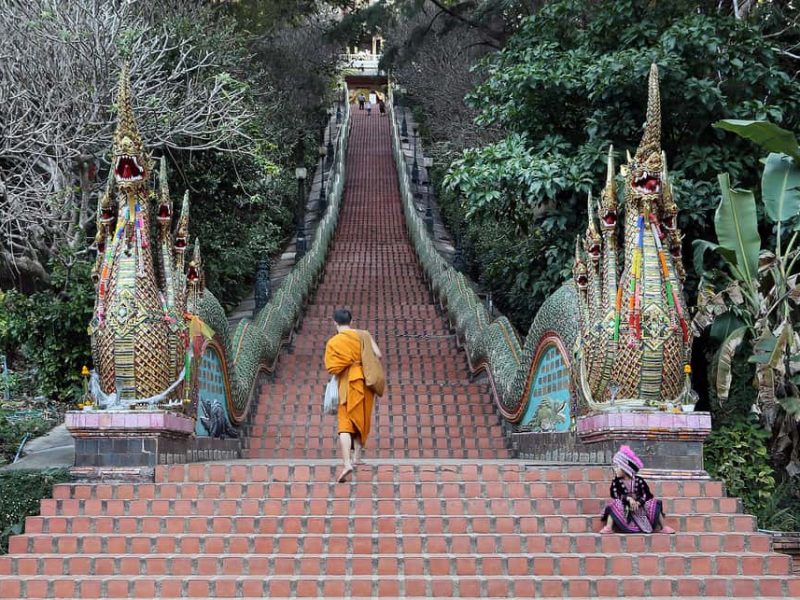
3.7. Trekking from Baan Pha Dang to Huay Ku Kap
Follow the trails from Baan Pha Dang to Huay Ku Kap, home to many unique scenic wonders. You can experience the culture of the hill tribes, which is the main reason why this trail became popular. The best element of this trek is experiencing the villagers’ lifestyle and learning more about their heyday in this area.
The 3-hour trekking begins at meditative cliffs and passes through quaint mountain cliffs, meandering streams, and several local villages held by Hill tribes. This is a prominent part of the panorama of Northern Thailand; you will pass some eye-catching destinations along the way like Mae Taman and finally touch Huay Kukap, which is famous for its impressive tribal settlement on the hill.
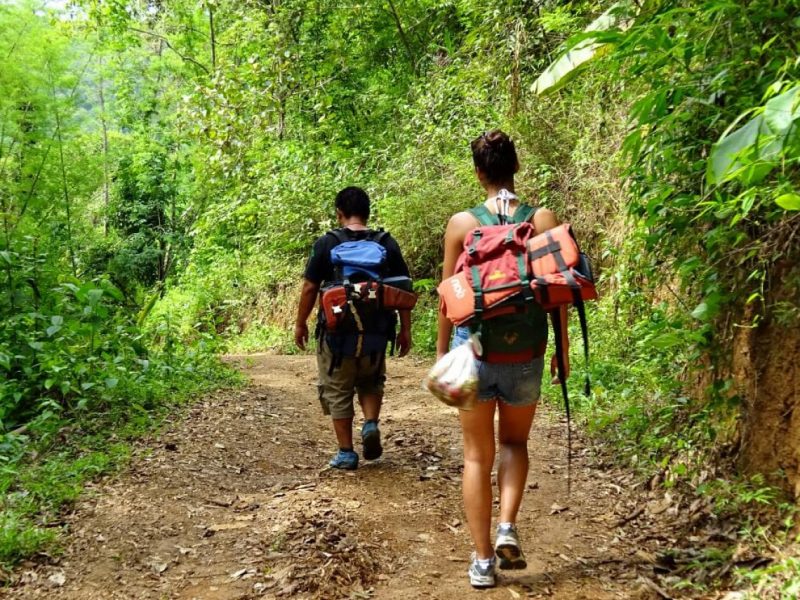
3.8. Trekking Mae Wang
Nature is at its best at Mae Wang in Chiang Mai, and one can experience the best of nature through a number of trekking tours offered in this part of Thailand. Trekking routes are basically available at Mae Wang National Park, starting from the fascinating Shan village.
Mae Wang National Park is famous for its Gran Canyon-like hill formation, located about 45 kilometers southwest of Chiang Mai city. Mae Wang National Park covers an area of 700 square kilometers in the Pa Mae Cham, Pa Mae Khan-Mae Wang, and Pa Chomthong National Conservation Forests in Chiang Mai. There are several elephant camps in this area that offer elephant and mahout riding courses. You can ride rubber boats and bamboo rafts on the Wang (Mae Wang) River.

As the tour begins, you can explore the natural wonders of the countryside, leading to waterfalls and rainforests that are equally beautiful in this area. You can also visit tribal villages in other fields, like Karen village, and learn more about the local people’s lives.

4. Notes when trekking Chiang Mai
- Always carry the right gear for hiking and pack extra layers, as it tends to get cold at night or early in the morning at higher altitudes.
- Choose clothes that are comfortable—not too tight, as it can cause stuffiness.
- Always wear good hiking boots or hiking boots with good grip.
- Always carry a water bottle with you to stay hydrated
- Bring sunscreen to avoid sunburn or sunburn
- Bring insect repellent to avoid being bitten by mosquitoes or any other insects.
- Always carry a first aid kit with you so you can handle minor medical emergencies.
- You should choose a trekking route that suits your abilities. You should do appropriate training before trekking and ensure your health.
- If this is your first time to Chiang Mai or you have not experienced walking, it is better to join a tour with a guide rather than go it alone.
- Please respect Thai culture and customs. When visiting a hill tribe, interact with the people rather than just looking at them and taking pictures.
- Don’t leave any trash behind when you’re out climbing, and take care not to damage or interfere with any plants or wildlife you may encounter during your trip.
5. Conclusion
Above are the top 8 most prominent roads in the Chiang Mai trekking tour that Metta Voyage shares with you. I hope you will have the most complete trekking tour. If you have any questions about the trip, you can contact us immediately.
Contact us
Website: www.mettavoyage.com
Email: info@mettavoyage.com
Hotline 24/7: + 84 989 383 572

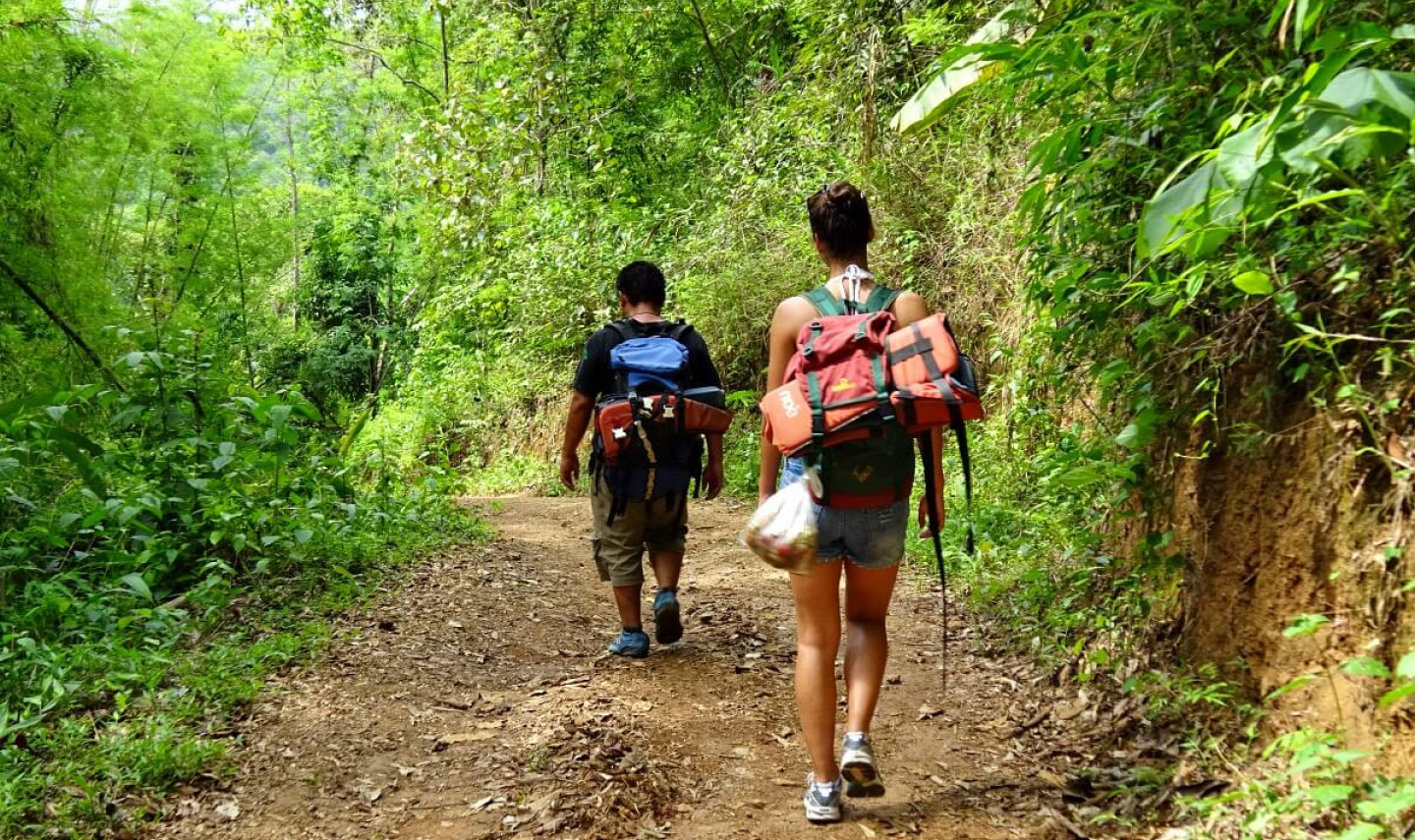

0 Comment